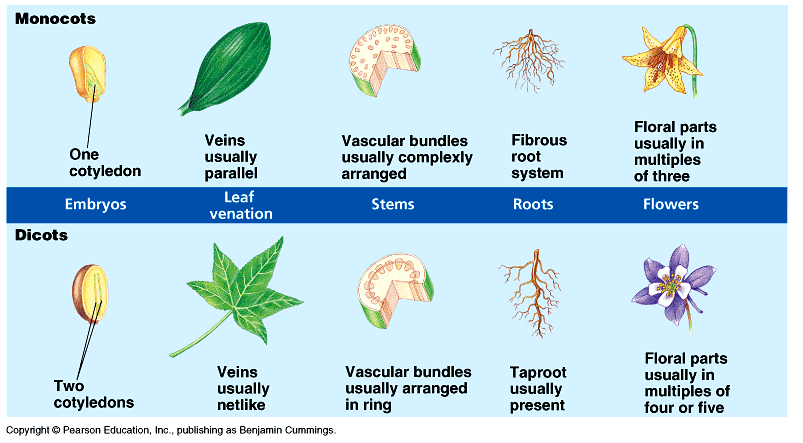CLASSIFICATION II. KINGDOM PLANTAE
General
features:
-Plants are multicellular, eukaryotic organism.
-Plants are multicellular, eukaryotic organism.
-Their cells have cell walls made of cellulose.
-Have chlorophyll, i.e. the green light
trapping pigment.
-Plants manufacture their own food by the process of photosynthesis,
i.e. plants are autotrophs.
-They reproduce both sexually
and asexually.
Comparing animals, plants & fungi.
FUNGI
|
PLANTS
|
ANIMALS
|
-Cell wall made of chitin
|
-Cell wall made of cellulose
|
-No cell wall. Chitin found in insect skeleton
|
-store sugar in form of glycogen
|
- store starch
|
-store sugar in form of glycogen
|
-Chromosomes lack proteins
|
-Chromosomes have protein
|
-Chromosomes have protein
|
-cells have centrioles
|
-Cells lack centrioles
|
-Cells have centrioles
|
-Cell division-new cells by formation of new cell
wall across the cell
|
-Cell division-new cells by formation of new cell
wall across the cell
|
-Cell division-new cells by constriction of cell
coating
|
-Reproduce by spores
|
-Reproduce by spores and gametes
|
-Reproduce by gametes (sperm & ova)
|
-Mitosis is completed within the nuclear membrane
|
-Nuclear membrane disappears during mitosis
|
-Nuclear membrane disappears during mitosis
|
Economic
importance of plants
Plants give out fresh air needed by animals, i.e. oxygen.
Plants give out fresh air needed by animals, i.e. oxygen.
- Plants
produce soft wood for paper making.
- They also
produce hard wood for furniture and other construction and building
purposes.
- used as
fuel e.g. charcoal and fire wood.
- Act as wind
breakers during strong winds.
- Acts as
cover crop to prevent soil erosion.
- Are used to
make medicine e.g. Neem tree( Mwarubaini) and pyrethrum.
- Shelter and
habitat for the wild animals.
- As food for
animals and human beings.
- For beauty
and decoration.
- After death
they decompose and add soil fertility.
- Forest
areas act as carbon sinks.
- Forest
areas act as water catchments areas.
- Produce
rubber for tyres.
- Used in textile
industries e.g. cotton
- Some are
used in cosmetic making and perfumes.
- Some are
used as stimulants, e.g. Heroin, Caffeine
Division of plantae:
1. Bryophyta
eg: mosses, liverworts and
hornworts.
2. Pteridophyta eg: Ferns (seedless plant)
3. Spermatophyta-seed bearing plants.
Eg: a: Gymnospermae class, e.g.: pines,
conifers, Cyprus.
b: Angiospermae class: i. Monocotyledons, e.g.: maize
ii.
dicotyledons, e.g. beans.
Coniferophyta (Conifers)
· Seeds produced after fertilization are
always naked, i.e. Not protected by the ovary.
· Leaves remain green through out the year,
i.e. Needle like with thick waxy cuticle.
· Are cone bearing plants.
· Contain xylem and phloem.
· They are seed bearing plants.
· Sexual reproduction is well defined.
· Almost all are terrestrial.
· Well defined system of roots, stem and
leaves.
· Secondary thickening.
· Examples are pine, cedar, juniper, cyperus, spruce,
Demerits of Conifers
1.May shelter dangerous organisms that are
dangerous to human being like snakes and wasps.
2.They do not produce fruits.
Angiospermophyta.
These include: -Herbs,
i.e. small soft plants usually annuals or perennials.
-Shrubs,
i.e. Small woody plants that live many years.
-Trees,
i.e. Tall and large woody plants. Live many years.
Main features.
· All are flowering plants.
· Majority are terrestrial.
· Fertilization is preceded by growth of the
pollen tube.
· Seeds are protected by the ovary.
· After fertilization the ovary matures into
a fruit enclosing one or more seeds.
· They also produce asexually through
vegetative propagation.
· Well developed system of root, stem and
leaves.
· Vascular tissues (xylem and phloem) are
present and well developed.
1.Some flowers are allergic to man, i.e.
pollen grains can cause asthma.
2.Some act as weeds, hence hindering growth
of other plants.
3.Potted plants in the house compete with man
for oxygen. (so do not keep many flowers in the room at night.)
4.Some are poisonous, i.e. pyrethrum, variety
of cassava.
5.Some have thorns that can injure human and
other animals.
Similarities between Angiosperm and Conifers.
-Both posses
complex vascular bundles.
-Both are higher
plants.
Differences between Angiosperm and Conifers
-Angiosperm are
more beautiful hence used for decorations.
-Angiosperm have
flowers while conifers have not.
-Angiosperm have
fruits
-Angiosperm have
covered seed while conifers have naked seed
The division has two classes:
a. Monocotyledoneae:
ie. Palms, Bamboo, Maize, wheat, sisal, sugarcane, millet, banana, lilies,
orchid.
b. Dicotyledoneae: ie. Beans, black
jack, coffee, mangoes, jacaranda, eucalyptus.
Differences between Monocoty and dicoty

or
Monocotyledoneae
i. Vascular bundles small and scattered in
the stem.
ii. Leaves are long and narrow.
iii. Leaves with parallel venation.
iv.
Fibrous
root system.
v. Embryo with one seed leaf or cotyledon.
vi.
No
pith in the stem.
vii. Floral parts in three or multiples of
three.
viii. No Vascular cambium, i.e. No secondary
growth.
|
Dicotyledoneae
ii. Broad leaves.
iii. Leaves with net like venation.
iv. Have tap root system.
v. Embryo with two cotyledons.
vi. Presence of pith in the stem.
vii. Floral parts in four or five or multiples
of four or five.
viii. Vascular cambium is present in both roots
and stems hence secondary growth.
|